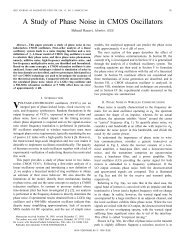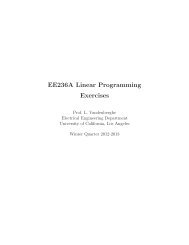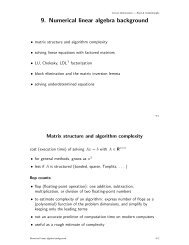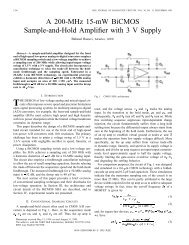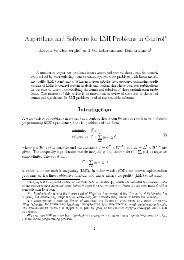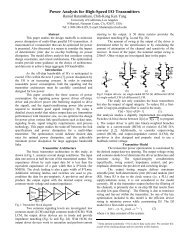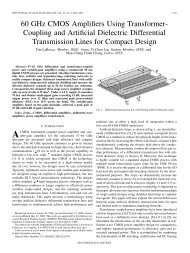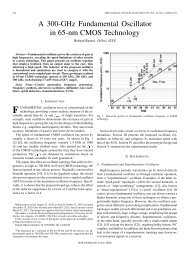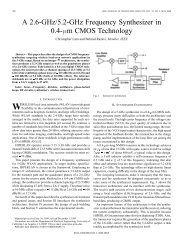7. Fast proximal gradient methods
7. Fast proximal gradient methods
7. Fast proximal gradient methods
You also want an ePaper? Increase the reach of your titles
YUMPU automatically turns print PDFs into web optimized ePapers that Google loves.
<strong>7.</strong> <strong>Fast</strong> <strong>proximal</strong> <strong>gradient</strong> <strong>methods</strong><br />
• fast <strong>proximal</strong> <strong>gradient</strong> method (FISTA)<br />
• FISTA with line search<br />
• FISTA as descent method<br />
• Nesterov’s second method<br />
EE236C (Spring 2011-12)<br />
7-1
<strong>Fast</strong> (<strong>proximal</strong>) <strong>gradient</strong> <strong>methods</strong><br />
• Nesterov (1983, 1988, 2005): three <strong>gradient</strong> projection <strong>methods</strong> with<br />
1/k 2 convergence rate<br />
• Beck & Teboulle (2008): FISTA, a <strong>proximal</strong> <strong>gradient</strong> version of<br />
Nesterov’s 1983 method<br />
• Nesterov (2004 book), Tseng (2008): overview and unified analysis of<br />
fast <strong>gradient</strong> <strong>methods</strong><br />
• several recent variations and extensions<br />
this lecture:<br />
FISTA and Nesterov’s 2nd method (1988) as presented by Tseng<br />
<strong>Fast</strong> <strong>proximal</strong> <strong>gradient</strong> <strong>methods</strong> 7-2
Outline<br />
• fast <strong>proximal</strong> <strong>gradient</strong> method (FISTA)<br />
• FISTA with line search<br />
• FISTA as descent method<br />
• Nesterov’s second method
FISTA (basic version)<br />
minimize f(x) = g(x)+h(x)<br />
• g convex, differentiable, with domg = R n<br />
• h closed, convex, with inexpensive prox th operator<br />
algorithm: choose any x (0) = x (−1) ; for k ≥ 1, repeat the steps<br />
y = x (k−1) +<br />
k −2<br />
k +1 (x(k−1) −x (k−2) )<br />
x (k) = prox tkh(y −tk∇g(y))<br />
• step size tk fixed or determined by line search<br />
• acronym stands for ‘<strong>Fast</strong> Iterative Shrinkage-Thresholding Algorithm’<br />
<strong>Fast</strong> <strong>proximal</strong> <strong>gradient</strong> <strong>methods</strong> 7-3
Interpretation<br />
• first iteration (k = 1) is a <strong>proximal</strong> <strong>gradient</strong> step at y = x (0)<br />
• next iterations are <strong>proximal</strong> <strong>gradient</strong> steps at extrapolated points y<br />
x (k−2) x (k−1) y<br />
x (k) = prox tkh(y −tk∇g(y))<br />
note: x (k) is feasible (in domh); y may be outside domh<br />
<strong>Fast</strong> <strong>proximal</strong> <strong>gradient</strong> <strong>methods</strong> 7-4
Example<br />
minimize log m<br />
exp(a<br />
i=1<br />
T i x+bi)<br />
randomly generated data with m = 2000, n = 1000, same fixed step size<br />
f(x (k) ) − f ⋆<br />
|f ⋆ |<br />
10 0<br />
10 -1<br />
10 -2<br />
10 -3<br />
10 -4<br />
10 -5<br />
10 -6<br />
<strong>gradient</strong><br />
FISTA<br />
0 50 100 150 200<br />
k<br />
<strong>Fast</strong> <strong>proximal</strong> <strong>gradient</strong> <strong>methods</strong> 7-5
another instance<br />
f(x (k) ) − f ⋆<br />
|f ⋆ |<br />
10 0<br />
10 -1<br />
10 -2<br />
10 -3<br />
10 -4<br />
10 -5<br />
10 -6<br />
FISTA is not a descent method<br />
<strong>gradient</strong><br />
FISTA<br />
0 50 100 150 200<br />
<strong>Fast</strong> <strong>proximal</strong> <strong>gradient</strong> <strong>methods</strong> 7-6<br />
k
assumptions<br />
Convergence of FISTA<br />
• g convex with domg = R n ; ∇g Lipschitz continuous with constant L:<br />
∇g(x)−∇g(y)2 ≤ Lx−y2 ∀x,y<br />
• h is closed and convex (so that prox th(u) is well defined)<br />
• optimal value f ⋆ is finite and attained at x ⋆ (not necessarily unique)<br />
convergence result: f(x (k) )−f ⋆ decreases at least as fast as 1/k 2<br />
• with fixed step size tk = 1/L<br />
• with suitable line search<br />
<strong>Fast</strong> <strong>proximal</strong> <strong>gradient</strong> <strong>methods</strong> 7-7
Reformulation of FISTA<br />
define θk = 2/(k +1) and introduce an intermediate variable v (k)<br />
algorithm: choose x (0) = v (0) ; for k ≥ 1, repeat the steps<br />
y = (1−θk)x (k−1) +θkv (k−1)<br />
x (k) = prox tkh(y −tk∇g(y))<br />
v (k) = x (k−1) + 1<br />
(x<br />
θk<br />
(k) −x (k−1) )<br />
substituting expression for v (k) in formula for y gives FISTA of page 7-3<br />
<strong>Fast</strong> <strong>proximal</strong> <strong>gradient</strong> <strong>methods</strong> 7-8
Important inequalities<br />
choice of θk: the sequence θk = 2/(k +1) satisfies θ1 = 1 and<br />
1−θk<br />
θ 2 k<br />
≤ 1<br />
θ2 , k ≥ 2<br />
k−1<br />
upper bound on g from Lipschitz property (page 1-14)<br />
g(u) ≤ g(z)+∇g(z) T (u−z)+ L<br />
2 u−z2 2 ∀u,z<br />
upper bound on h from definition of prox-operator (page 6-8)<br />
h(u) ≤ h(z)+ 1<br />
t (w−u)T (u−z) ∀w, u = prox th(w), z<br />
<strong>Fast</strong> <strong>proximal</strong> <strong>gradient</strong> <strong>methods</strong> 7-9
Progress in one iteration<br />
define x = x (i−1) , x + = x (i) , v = v (i−1) , v + = v (i) , t = ti, θ = θi<br />
• upper bound from Lipschitz property: if 0 < t ≤ 1/L,<br />
g(x + ) ≤ g(y)+∇g(y) T (x + −y)+ 1<br />
2t x+ −y 2 2<br />
• upper bound from definition of prox-operator:<br />
h(x + ) ≤ h(z)+∇g(y) T (z −x + )+ 1<br />
t (x+ −y) T (z −x + ) ∀z<br />
• add the upper bounds and use convexity of g<br />
f(x + ) ≤ f(z)+ 1<br />
t (x+ −y) T (z −x + )+ 1<br />
2t x+ −y 2 2 ∀z<br />
<strong>Fast</strong> <strong>proximal</strong> <strong>gradient</strong> <strong>methods</strong> 7-10<br />
(1)
• make convex combination of upper bounds for z = x and z = x ⋆<br />
f(x + )−f ⋆ −(1−θ)(f(x)−f ⋆ )<br />
= f(x + )−θf ⋆ −(1−θ)f(x)<br />
≤ 1<br />
= 1<br />
2t<br />
= θ2<br />
2t<br />
t (x+ −y) T (θx ⋆ +(1−θ)x−x + )+ 1<br />
2t x+ −y 2 2<br />
<br />
y −(1−θ)x−θx ⋆ 2<br />
2 − x + −(1−θ)x−θx ⋆ 2<br />
2<br />
<br />
v −x ⋆ 2<br />
2 − v + −x ⋆ 2<br />
2<br />
conclusion: if the inequality (1) holds at iteration i, then<br />
ti<br />
θ 2 i<br />
<br />
f(x (i) )−f ⋆<br />
≤ (1−θi)ti<br />
θ 2 i<br />
<br />
+ 1<br />
2 v(i) −x ⋆ 2 2<br />
<br />
f(x (i−1 )−f ⋆<br />
+ 1<br />
2 v(i−1) −x ⋆ 2 2<br />
<strong>Fast</strong> <strong>proximal</strong> <strong>gradient</strong> <strong>methods</strong> 7-11<br />
<br />
(2)
Analysis for fixed step size<br />
take ti = t = 1/L and apply (2) recursively, using (1−θi)/θ 2 i ≤ 1/θ2 i−1 :<br />
therefore,<br />
t<br />
θ 2 k<br />
<br />
f(x (k) )−f ⋆<br />
≤ (1−θ1)t<br />
θ 2 1<br />
= 1<br />
2 x(0) −x ⋆ 2 2<br />
+ 1<br />
2 v(k) −x ⋆ 2 2<br />
<br />
f(x (0) )−f ⋆<br />
+ 1<br />
2 v(0) −x ⋆ 2 2<br />
f(x (k) )−f ⋆ ≤ θ2 k<br />
2t x(0) −x ⋆ 2 2 = 2L<br />
(k +1) 2x(0) −x ⋆ 2 2<br />
conclusion: reaches f(x (k) )−f ⋆ ≤ ǫ after O(1/ √ ǫ) iterations<br />
<strong>Fast</strong> <strong>proximal</strong> <strong>gradient</strong> <strong>methods</strong> 7-12
Example: quadratic program with box constraints<br />
(f(x (k) ) − f ⋆ )/|f ⋆ |<br />
10 1<br />
10 0<br />
10 -1<br />
10 -2<br />
10 -3<br />
10 -4<br />
10 -5<br />
10 -6<br />
10 -7<br />
minimize (1/2)x T Ax+b T x<br />
subject to 0 x 1<br />
<strong>gradient</strong><br />
FISTA<br />
0 10 20 30 40 50<br />
n = 3000; fixed step size t = 1/λmax(A)<br />
<strong>Fast</strong> <strong>proximal</strong> <strong>gradient</strong> <strong>methods</strong> 7-13<br />
k
(f(x (k) ) − f ⋆ )/f ⋆<br />
10 0<br />
10 -1<br />
10 -2<br />
10 -3<br />
10 -4<br />
10 -5<br />
10 -6<br />
10 -7<br />
1-norm regularized least-squares<br />
minimize<br />
1<br />
2 Ax−b2 2+x1<br />
<strong>gradient</strong><br />
FISTA<br />
0 20 40 60 80 100<br />
randomly generated A ∈ R 2000×1000 ; step tk = 1/L with L = λmax(A T A)<br />
<strong>Fast</strong> <strong>proximal</strong> <strong>gradient</strong> <strong>methods</strong> 7-14<br />
k
Outline<br />
• fast <strong>proximal</strong> <strong>gradient</strong> method (FISTA)<br />
• FISTA with line search<br />
• FISTA as descent method<br />
• Nesterov’s second method
Key steps in the analysis of FISTA<br />
• the starting point (page 7-10) is the inequality<br />
g(x + ) ≤ g(y)+∇g(y) T (x + −y)+ 1<br />
2t x+ −y 2 2<br />
this inequality is known to hold for 0 < t ≤ 1/L<br />
• if (1) holds, then the progress made in iteration i is bounded by<br />
ti<br />
θ 2 i<br />
<br />
f(x (i) )−f ⋆<br />
≤ (1−θi)ti<br />
θ 2 i<br />
+ 1<br />
2 v(i) −x ⋆ 2 2<br />
<br />
f(x (i−1 )−f ⋆<br />
• to combine these inequalities recursively, we need<br />
(1−θi)ti<br />
θ 2 i<br />
≤ ti−1<br />
θ 2 i−1<br />
+ 1<br />
2 v(i−1) −x ⋆ 2 2<br />
(1)<br />
(2)<br />
(i ≥ 2) (3)<br />
<strong>Fast</strong> <strong>proximal</strong> <strong>gradient</strong> <strong>methods</strong> 7-15
• if θ1 = 1, combining the inequalities (2) from i = 1 to k gives the bound<br />
f(x (k) )−f ⋆ ≤ θ2 k<br />
2tk<br />
x (0) −x ⋆ 2 2<br />
conclusion: rate 1/k 2 convergence if (1) and (3) hold with<br />
FISTA with fixed step size<br />
θ 2 k<br />
tk<br />
these values satisfy (1) and (3) with<br />
= O( 1<br />
k 2)<br />
tk = 1<br />
L , θk = 2<br />
k +1<br />
θ 2 k<br />
tk<br />
= 4L<br />
(k +1) 2<br />
<strong>Fast</strong> <strong>proximal</strong> <strong>gradient</strong> <strong>methods</strong> 7-16
FISTA with line search (method 1)<br />
replace update of x in iteration k (page 7-8) with<br />
t := tk−1 (define t0 = ˆt > 0)<br />
x := prox th(y −t∇g(y))<br />
while g(x) > g(y)+∇g(y) T (x−y)+ 1<br />
2t x−y2 2<br />
t := βt<br />
x := prox th(y −t∇g(y))<br />
end<br />
• inequality (1) holds trivially, by the backtracking exit condition<br />
• inequality (3) holds with θk = 2/(k +1) because tk ≤ tk−1<br />
• Lipschitz continuity of ∇g guarantees tk ≥ tmin = min{ˆt,β/L}<br />
• preserves 1/k 2 convergence rate because θ 2 k /tk = O(1/k 2 ):<br />
θ 2 k<br />
tk<br />
≤<br />
4<br />
(k +1) 2 tmin<br />
<strong>Fast</strong> <strong>proximal</strong> <strong>gradient</strong> <strong>methods</strong> 7-17
FISTA with line search (method 2)<br />
replace update of y and x in iteration k (page 7-8) with<br />
t := ˆt > 0<br />
θ := positive root of tk−1θ 2 = tθ 2 k−1 (1−θ)<br />
y := (1−θ)x (k−1) +θv (k−1)<br />
x := prox th(y −t∇g(y))<br />
while g(x) > g(y)+∇g(y) T (x−y)+ 1<br />
2t x−y2 2<br />
t := βt<br />
θ := positive root of tk−1θ 2 = tθ 2 k−1 (1−θ)<br />
end<br />
y := (1−θ)x (k−1) +θv (k−1)<br />
x := prox th(y −t∇g(y))<br />
assume t0 = 0 in the first iteration (k = 1), i.e., take θ1 = 1, y = x (0)<br />
<strong>Fast</strong> <strong>proximal</strong> <strong>gradient</strong> <strong>methods</strong> 7-18
discussion<br />
• inequality (1) holds trivially, by the backtracking exit condition<br />
• inequality (3) holds trivially, by construction of θk<br />
• Lipschitz continuity of ∇g guarantees tk ≥ tmin = min{ˆt,β/L}<br />
• θi is defined as the positive root of θ 2 i /ti = (1−θi)θ 2 i−1 /ti−1; hence<br />
√ ti−1<br />
θi−1<br />
=<br />
(1−θi)ti<br />
θi<br />
≤<br />
√ ti<br />
combine inequalities from i = 2 to k to get √ t1 ≤<br />
• rearranging shows that θ 2 k /tk = O(1/k 2 ):<br />
θ 2 k<br />
tk<br />
≤<br />
√t1+ 1<br />
2<br />
1<br />
k<br />
i=2<br />
√ ti<br />
2 ≤<br />
θi<br />
−<br />
√ ti<br />
4<br />
2<br />
√ tk<br />
θk<br />
(k +1) 2 tmin<br />
− 1<br />
2<br />
k √<br />
ti<br />
<strong>Fast</strong> <strong>proximal</strong> <strong>gradient</strong> <strong>methods</strong> 7-19<br />
i=2
method 1<br />
Comparison of line search <strong>methods</strong><br />
• uses nonincreasing step sizes (enforces tk ≤ tk−1)<br />
• one evaluation of g(x), one prox th evaluation per line search iteration<br />
method 2<br />
• allows non-monotonic step sizes<br />
• one evaluation of g(x), one evaluation of g(y), ∇g(y), one evaluation of<br />
prox th per line search iteration<br />
the two strategies can be combined and extended in various ways<br />
<strong>Fast</strong> <strong>proximal</strong> <strong>gradient</strong> <strong>methods</strong> 7-20
Outline<br />
• fast <strong>proximal</strong> <strong>gradient</strong> method (FISTA)<br />
• FISTA with line search<br />
• FISTA as descent method<br />
• Nesterov’s second method
Descent version of FISTA<br />
choose x (0) = v (0) ; for k ≥ 1, repeat the steps<br />
y = (1−θk)x (k−1) +θkv (k−1)<br />
u = prox tkh(y −tk∇g(y))<br />
x (k) =<br />
u f(u) ≤ f(x (k−1) )<br />
v (k) = x (k−1) + 1<br />
• step 3 implies f(x (k) ) ≤ f(x (k−1) )<br />
x (k−1) otherwise<br />
θk<br />
(u−x (k−1) )<br />
• use θk = 2/(k +1) and tk = 1/L, or one of the line search <strong>methods</strong><br />
• same iteration complexity as original FISTA<br />
• changes on page 7-10: replace x + with u and use f(x + ) ≤ f(u)<br />
<strong>Fast</strong> <strong>proximal</strong> <strong>gradient</strong> <strong>methods</strong> 7-21
(from page 7-6)<br />
(f(x (k) ) − f ⋆ )/|f ⋆ |<br />
10 0<br />
10 -1<br />
10 -2<br />
10 -3<br />
10 -4<br />
10 -5<br />
10 -6<br />
Example<br />
<strong>gradient</strong><br />
FISTA<br />
FISTA-d<br />
0 50 100 150 200<br />
<strong>Fast</strong> <strong>proximal</strong> <strong>gradient</strong> <strong>methods</strong> 7-22<br />
k
Outline<br />
• fast <strong>proximal</strong> <strong>gradient</strong> method (FISTA)<br />
• line search strategies<br />
• enforcing descent<br />
• Nesterov’s second method
Nesterov’s second method<br />
algorithm: choose x (0) = v (0) ; for k ≥ 1, repeat the steps<br />
y = (1−θk)x (k−1) +θkv (k−1)<br />
v (k) = prox (tk/θ k)h<br />
<br />
v (k−1) − tk<br />
x (k) = (1−θk)x (k−1) +θkv (k)<br />
θk<br />
<br />
∇g(y)<br />
• use θk = 2/(k +1) and tk = 1/L, or one of the line search <strong>methods</strong><br />
• identical to FISTA if h(x) = 0<br />
• unlike in FISTA, y is feasible (in domh) if we take x (0) ∈ domh<br />
<strong>Fast</strong> <strong>proximal</strong> <strong>gradient</strong> <strong>methods</strong> 7-23
assumptions<br />
Convergence of Nesterov’s second method<br />
• g convex; ∇g is Lipschitz continuous on domh ⊆ domg<br />
∇g(x)−∇g(y)2 ≤ Lx−y2 ∀x,y ∈ domh<br />
• h is closed and convex (so that prox th(u) is well defined)<br />
• optimal value f ⋆ is finite and attained at x ⋆ (not necessarily unique)<br />
convergence result: f(x (k) )−f ⋆ decreases at least as fast as 1/k 2<br />
• with fixed step size tk = 1/L<br />
• with suitable line search<br />
<strong>Fast</strong> <strong>proximal</strong> <strong>gradient</strong> <strong>methods</strong> 7-24
Analysis of one iteration<br />
define x = x (i−1) , x + = x (i) , v = v (i−1) , v + = v (i) , t = ti, θ = θi<br />
• from Lipschitz property if 0 < t ≤ 1/L<br />
g(x + ) ≤ g(y)+∇g(y) T (x + −y)+ 1<br />
2t x+ −y 2 2<br />
• plug in x + = (1−θ)x+θv + and x + −y = θ(v + −v)<br />
g(x + ) ≤ g(y)+∇g(y) T (1−θ)x+θv + −y + θ2<br />
2t v+ −v 2 2<br />
• from convexity of g, h<br />
g(x + ) ≤ (1−θ)g(x)+θ g(y)+∇g(y) T (v + −y) + θ2<br />
2t v+ −v 2 2<br />
h(x + ) ≤ (1−θ)h(x)+θh(v + )<br />
<strong>Fast</strong> <strong>proximal</strong> <strong>gradient</strong> <strong>methods</strong> 7-25
• upper bound on h from p. 7-9 (with u = v + , w = v −(t/θ)∇g(y))<br />
h(v + ) ≤ h(z)+∇g(y) T (z −v + )− θ<br />
t (v+ −v) T (v + −z) ∀z<br />
• combine the upper bounds on g(x + ), h(x + ), h(v + ) with z = x ⋆<br />
f(x + ) ≤ (1−θ)f(x)+θf ⋆ − θ2<br />
t (v+ −v) T (v + −x ⋆ )+ θ2<br />
2t v+ −v 2 2<br />
= (1−θ)f(x)+θf ⋆ + θ2<br />
2t<br />
⋆ 2<br />
v −x 2−v + −x ⋆ 2 2<br />
this is identical to the final inequality (2) in the analysis of FISTA on p.7-11<br />
ti<br />
θ 2 i<br />
<br />
f(x (i) )−f ⋆<br />
≤ (1−θi)ti<br />
θ 2 i<br />
+ 1<br />
2 v(i) −x ⋆ 2 2<br />
<br />
f(x (i−1 ))−f ⋆<br />
+ 1<br />
2 v(i−1) −x ⋆ 2 2<br />
<strong>Fast</strong> <strong>proximal</strong> <strong>gradient</strong> <strong>methods</strong> 7-26
surveys of fast <strong>gradient</strong> <strong>methods</strong><br />
References<br />
• Yu. Nesterov, Introductory Lectures on Convex Optimization. A Basic Course (2004)<br />
• P. Tseng, On accelerated <strong>proximal</strong> <strong>gradient</strong> <strong>methods</strong> for convex-concave optimization<br />
(2008)<br />
FISTA<br />
• A. Beck and M. Teboulle, A fast iterative shrinkage-thresholding algorithm for linear<br />
inverse problems, SIAM J. on Imaging Sciences (2009)<br />
• A. Beck and M. Teboulle, Gradient-based algorithms with applications to signal<br />
recovery, in: Y. Eldar and D. Palomar (Eds.), Convex Optimization in Signal<br />
Processing and Communications (2009)<br />
line search strategies<br />
• FISTA papers by Beck and Teboulle<br />
• D. Goldfarb and K. Scheinberg, <strong>Fast</strong> first-order <strong>methods</strong> for composite convex<br />
optimization with line search (2011)<br />
• Yu. Nesterov, Gradient <strong>methods</strong> for minimizing composite objective function (2007)<br />
• O. Güler, New <strong>proximal</strong> point algorithms for convex minimization, SIOPT (1992)<br />
<strong>Fast</strong> <strong>proximal</strong> <strong>gradient</strong> <strong>methods</strong> 7-27
Nesterov’s third method (not covered in this lecture)<br />
• Yu. Nesterov, Smooth minimization of non-smooth functions, Mathematical<br />
Programming (2005)<br />
• S. Becker, J. Bobin, E.J. Candès, NESTA: a fast and accurate first-order method for<br />
sparse recovery, SIAM J. Imaging Sciences (2011)<br />
<strong>Fast</strong> <strong>proximal</strong> <strong>gradient</strong> <strong>methods</strong> 7-28




